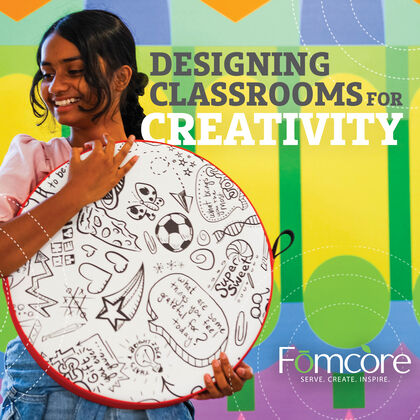Loading...

Designing Classrooms for Creativity: Tips for Building Spaces That Inspire
At Fōmcore, creativity is something we strive to bring into every space we design. We believe that the right environment can inspire students to be their best, fully engage in their learning spaces, and unlock their creative potential. But why is creativity so important in classrooms, and how can schools design spaces that encourage it?
The Importance of Creativity in the Classroom
Creativity is more than just a skill—it’s a way of thinking that fosters innovation, problem-solving, and adaptability. In today’s fast-changing world, creative thinking is crucial for students to navigate challenges and explore new ideas. Creativity is a critical part of student development, offering benefits that go beyond just artistic expression. Research has shown that fostering creativity in the classroom can have a profound impact on student growth:
- A study published in Frontiers in Psychology found that classrooms that encourage creativity can enhance students’ cognitive development, improve their problem-solving skills, and boost their overall academic performance.
- According to the World Economic Forum, creativity is one of the top skills that will be essential for the future workforce, as it allows individuals to adapt and thrive in a rapidly evolving environment.
- The American Psychological Association emphasizes that engaging students in creative activities can reduce stress and anxiety, leading to better emotional well-being and resilience in both school and life.
With creativity playing such a vital role in student development, designing classrooms that nurture this ability is more important than ever. Let’s explore some practical tips for creating spaces that inspire creativity and engagement in students.
Tips for Building Creative Classrooms
Designing a classroom that fosters creativity involves more than just rearranging desks—it’s about creating an environment that invites exploration, collaboration, and a sense of possibility. Here are some tips for building creative spaces in schools:
Create Zones for Different Types of Activities
Consider designing specific zones within the classroom for various activities—such as a quiet reading corner, a space for group discussions, and an area for hands-on projects. These dedicated spaces can encourage students to transition smoothly between focused, creative, and collaborative work.Provide Tools for Expression
Creativity flourishes when students have access to materials that encourage self-expression. This could mean including a whiteboard wall for brainstorming, art supplies for visual projects, or digital tools for multimedia creation. By giving students multiple ways to express their ideas, you create a space where their creativity can take shape in different forms.Encourage Movement and Choice
Movement is a key part of the creative process. Allowing students to move around, change their seating, or work in different parts of the room can stimulate their thinking and keep them engaged. Providing options for standing desks, soft seating, or floor seating gives students the freedom to choose how they want to work. This flexibility supports different learning styles and helps students feel more in control of their environment.Incorporate Flexible Furniture
Flexibility is key when it comes to creative spaces. Modular furniture allows students to rearrange their surroundings to suit different activities, whether they’re working individually, in small groups, or as a class. Our seating solutions are designed with this in mind, giving students the freedom to create the layout that best supports their learning.Bring in Natural Elements
Nature has a calming and inspiring effect on students. Incorporating elements like plants, natural light, and even textures that mimic nature can help stimulate creativity. Studies have shown that exposure to natural light improves mood and productivity, making it an essential consideration in classroom design. At Fōmcore, we’ve embraced this idea with pieces like our Campfire Combo, which mimics the look of an outdoor campfire and provides a comfy spot for students to collaborate while adding a touch of nature to the classroom.- Make It Playful and Fun
Play is a powerful driver of creativity. Including playful elements like vibrant colors, interactive displays, and games can make a classroom feel more inviting and encourage a sense of curiosity. When students feel comfortable and excited about their space, they’re more likely to take risks and explore new ideas.
Designing Spaces That Inspire
Creativity doesn’t happen in a vacuum—it thrives in spaces that are open, flexible, and filled with opportunities for exploration. At Fōmcore, our mission to inspire is about more than just furniture; it’s about creating environments where students feel empowered to think creatively, collaborate with peers, and engage deeply in their learning journey.
By designing classrooms that prioritize creativity, we can help students develop the skills they need to thrive not only in school but in the world beyond.
References
Frontiers in Psychology. (n.d.). Enhancing Cognitive Development Through Creative Classrooms.
World Economic Forum. (2020). The Future of Jobs Report: Top Skills for the Future Workforce.
American Psychological Association. (n.d.). The Role of Creativity in Student Well-being.
University of Salford. (n.d.). Classroom Design and Its Impact on Learning Rates.
Human Spaces. (n.d.). Biophilic Design and Student Engagement: The Role of Natural Light in Schools.